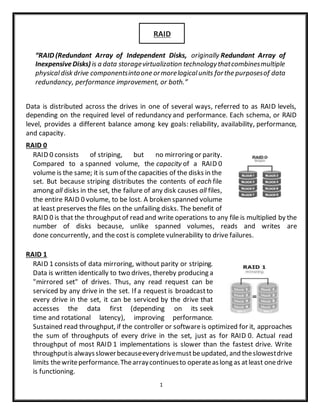
Raid (Redundant Array of Inexpensive Disks) in Computer Architecture
- 1. 1 “RAID (Redundant Array of Independent Disks, originally Redundant Array of InexpensiveDisks) is a data storagevirtualization technologythatcombinesmultiple physicaldisk drive componentsintoone ormorelogicalunits forthe purposesof data redundancy, performance improvement, or both.” Data is distributed across the drives in one of several ways, referred to as RAID levels, depending on the required level of redundancy and performance. Each schema, or RAID level, provides a different balance among key goals: reliability, availability, performance, and capacity. RAID 0 RAID 0 consists of striping, but no mirroring or parity. Compared to a spanned volume, the capacity of a RAID 0 volume is the same; it is sumof the capacities of the disks in the set. But because striping distributes the contents of each file among all disks in the set, the failure of any disk causes all files, the entire RAID 0 volume, to be lost. A broken spanned volume at least preserves the files on the unfailing disks. The benefit of RAID 0 is that the throughputof read and write operations to any file is multiplied by the number of disks because, unlike spanned volumes, reads and writes are done concurrently, and the cost is complete vulnerability to drive failures. RAID 1 RAID 1 consists of data mirroring, without parity or striping. Data is written identically to two drives, thereby producing a "mirrored set" of drives. Thus, any read request can be serviced by any drive in the set. If a request is broadcastto every drive in the set, it can be serviced by the drive that accesses the data first (depending on its seek time and rotational latency), improving performance. Sustained read throughput, if the controller or softwareis optimized for it, approaches the sum of throughputs of every drive in the set, just as for RAID 0. Actual read throughput of most RAID 1 implementations is slower than the fastest drive. Write throughputis alwaysslowerbecauseeverydrivemustbeupdated, and theslowestdrive limits thewriteperformance.Thearraycontinuesto operateaslong as atleast onedrive is functioning. RAID
- 2. 2 RAID 2 RAID 2 consists of bit-level striping with dedicated Hamming-codeparity. All disk spindle rotation is synchronized and data is striped such that each sequential bit is on a different drive. Hamming-code parity is calculated across corresponding bits and stored on at least one parity drive. This level is of historical significance only; although it was used on some early machines (for example, the Thinking Machines CM-2), as of 2014 it is not used by any commercially available system. RAID 3 RAID 3 consists of byte-levelstriping with dedicated parity. All disk spindle rotation is synchronized and data is striped suchthateach sequential byte is on a differentdrive. Parity is calculated across corresponding bytes and stored on a dedicated parity drive. Although implementations exist, RAID 3 is not commonly used in practice. RAID 4 RAID 4 consists of block-level striping with dedicated parity. This level was previously used by NetApp, but has now been largely replaced by a proprietary implementation of RAID 4 with two parity disks, called RAID-DP.Themain advantageof RAID 4over RAID 2 and 3 is I/O parallelism: in RAID 2 and 3, a single read I/O operation requires reading the wholegroupof data drives, while in RAID 4 one I/O read operation does not have to spread across all data drives. As a result, more I/O operations can be executed in parallel, improving the performance of small transfers. RAID 5 RAID 5 consists of block-level striping with distributed parity. Unlike RAID 4, parity information is distributed among the drives, requiring all drives but one to be present to operate. Upon failure of a single drive, subsequent reads can be calculated from the distributed parity such that no data is lost. RAID 5 requires at least
- 3. 3 three disks. RAID 5 implementations are susceptible to systemfailures because of trends regarding array rebuild time and the chance of drive failure during rebuild (see "Increasing rebuild time and failure probability" section, below). Rebuilding an array requires reading all data fromall disks, opening a chance for a second drive failure and the loss of the entire array. In August 2012, Dell posted an advisory against the use of RAID 5 in any configuration on Dell EqualLogic arrays and RAID 50 with "Class 2 7200 RPM drives of 1 TB and higher capacity" for business-critical data. RAID 6 RAID 6 consists of block-level striping with double distributed parity. Double parity provides fault toleranceup to two failed drives.This makeslarger RAID groups more practical, especially for high-availability systems, as large-capacity drives take longer to restore. RAID 6 requires a minimum of four disks. As with RAID 5, a single drive failure results in reduced performanceof theentire arrayuntil thefailed drivehas been replaced. With a RAID 6 array, using drives from multiple sources and manufacturers,itis possibleto mitigate mostof the problemsassociatedwith RAID 5.The larger the drive capacities and the larger the array size, the more important it becomes to choose RAID 6 instead of RAID 5. RAID 10 also minimizes these problems.